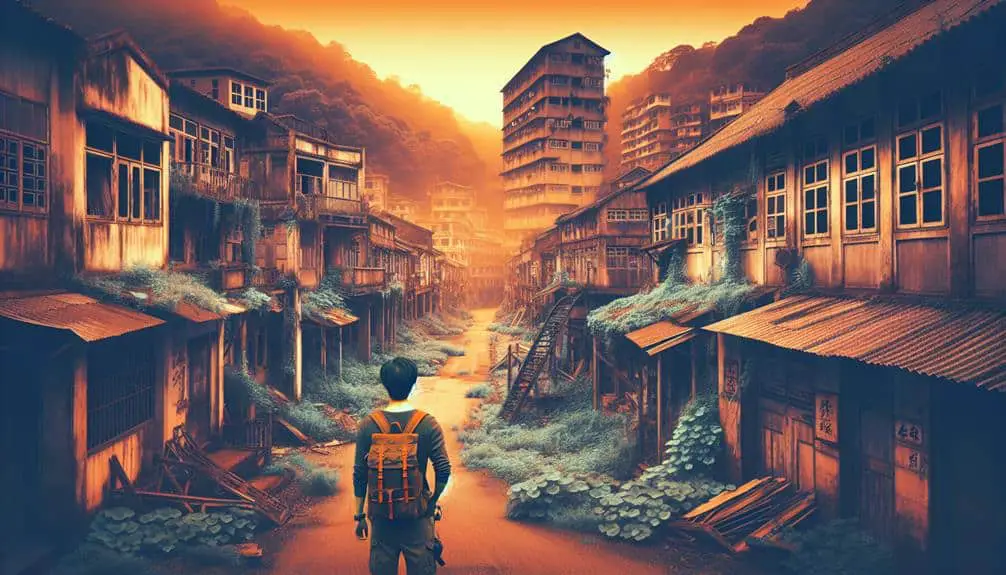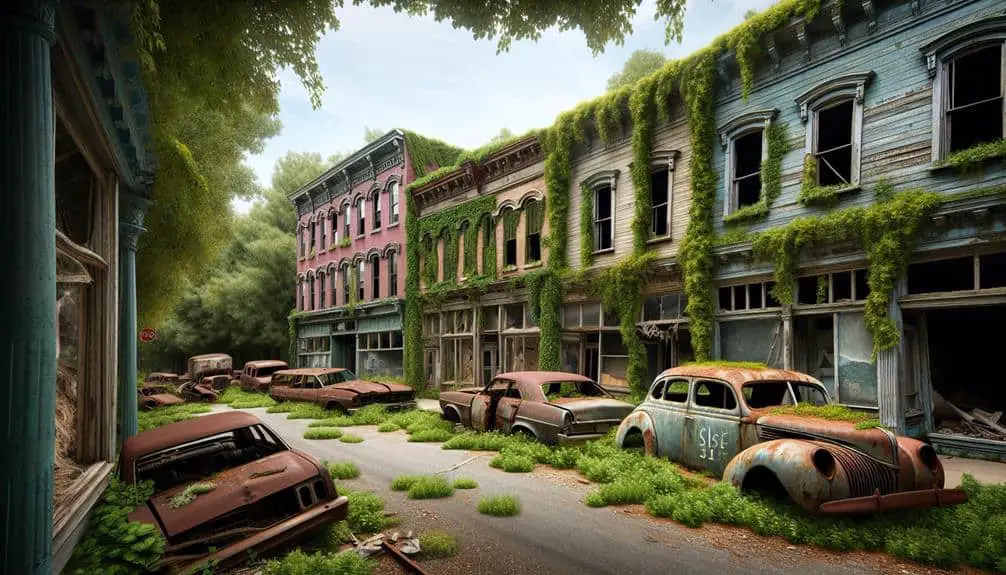To thrive in post-apocalyptic United States ghost towns, build strong relationships and share resources with the community. Scavenge cautiously for survival gear in abandoned buildings. Craft a sustainable lifestyle by growing crops and creating shelter. Stay quiet, travel in groups, and establish safe havens to navigate dangers. Utilize materials from abandoned structures for shelter and search for fertile soil for planting. Embrace challenges of food cultivation in harsh conditions. Resilience, resourcefulness, and community bonds are essential for your survival and thriving in the now desolate urban centers. Master these skills to carve out a life in this new world.
Key Points
- Repurpose abandoned structures for shelter and resources.
- Scout for fertile land and cultivate food with sustainable methods.
- Preserve and plant seeds for continuous food supply.
- Form resilient communities for safety and support.
- Utilize group travel and safe havens to navigate dangers.
The Resilient Community Bonds
Have you ever wondered how communities in post-apocalyptic ghost towns manage to maintain such resilient bonds amidst chaos and uncertainty? The key lies in their ability to foster strong resilient relationships and provide unwavering communal support. In these challenging times, individuals come together, realizing that their survival depends on the strength of their unity.
Communal support is the cornerstone of these ghost towns. People understand that by supporting one another, they increase their chances of survival and create a sense of belonging in a desolate world. Sharing resources, knowledge, and skills becomes not just a necessity but a way of life. The communal support network guarantees that no one is left behind, and everyone contributes to the greater good of the community.
Resilient relationships are forged through shared experiences and hardships. People lean on each other for emotional support, encouragement, and practical help. These bonds create a sense of solidarity and trust, crucial for maneuvering the uncertainties of a post-apocalyptic world. In the face of adversity, these communities stand strong, united in their mission to thrive against all odds.
Scavenging for Survival Supplies
Scavenging for vital survival supplies in post-apocalyptic ghost towns demands strategic planning and resourcefulness to secure essential resources for sustenance and protection. In this harsh new world, resourceful tactics are essential for your survival. When scavenging, prioritize essential gear such as clean water, non-perishable food, first aid kits, and protective clothing.
Start by exploring abandoned buildings, but remember to proceed with caution as structures may be unstable. Look for overlooked items like canned goods, tools, and medications. Be thorough but swift, as other survivors may also be searching for supplies.
Utilize your surroundings creatively; for example, repurpose items like tarps for shelter or containers for water storage. Consider venturing into less obvious locations like vehicles for fuel or medical facilities for prescription drugs. Keep a lookout for potential dangers such as contaminated food or hostile individuals.
Crafting a Sustainable Lifestyle
Crafting a sustainable lifestyle amidst the challenges of a post-apocalyptic world requires ingenuity and a strategic approach to guarantee long-term survival. Building shelter is fundamental for protection against the elements and potential threats. Utilize existing structures for quick fixes, reinforce them with scavenged materials, or construct new shelters using available resources like wood, metal, or abandoned vehicles. Consider camouflage to blend in and avoid drawing unwanted attention.
Growing food is essential for sustainability. Start small with easy-to-grow crops like beans, potatoes, or squash. Utilize any available space for gardening, including rooftops, balconies, or makeshift containers. Collect seeds from the environment or preserved sources for a continuous food supply. Embrace alternative methods such as hydroponics or vertical gardening to maximize limited space.
In this new world, your ability to adapt and innovate will determine your survival. By mastering the art of building shelter and growing food, you pave the way towards self-reliance and sustainable living. Stay resourceful, stay vigilant, and thrive in the face of adversity.
To survive the post-apocalyptic dangers, understanding threat assessment and strategic movement is essential. When exploring the desolate landscapes of ghost towns, you must be vigilant and adaptable. Here are some tips to help you avoid mutant creatures and form alliances with fellow survivors:
- Stay Low and Quiet: Keep a low profile to avoid attracting unwanted attention from mutant creatures that roam the streets.
- Scout Ahead: Before moving into unfamiliar terrain, send out scouts to assess potential dangers and identify safe routes.
- Travel in Groups: Strength lies in numbers. Form alliances with other survivors to increase your chances of survival against threats.
- Gather Intel: Information is key. Keep informed about local dangers and safe zones to plan your movements accordingly.
- Establish Safe Havens: Create designated safe areas where you and your allies can regroup, rest, and strategize for the journey ahead.
Thriving Amidst Desolate Landscapes
As you navigate the desolate landscapes of ghost towns, adapting to the challenges of a post-apocalyptic world becomes a test of resilience and resourcefulness. Building shelter is paramount in such environments. Utilize materials from abandoned structures or natural resources like wood and rocks to construct a sturdy refuge. Consider the layout for defense and ease of access to resources.
Growing food is essential for long-term survival. Explore the land for fertile soil and suitable areas for planting. Embrace sustainable practices like crop rotation and composting to maximize yields. Utilize any remaining seeds or scavenge for them in abandoned stores. Embrace the challenges of cultivating food in harsh conditions.
Frequently Asked Questions
What Are Some Tips for Maintaining Mental and Emotional Well-Being in a Post-Apocalyptic Ghost Town?
In a post-apocalyptic ghost town, focus on mindfulness practices for mental well-being. Seek emotional support from fellow survivors. Build a community for mutual care. Prioritize self-care to navigate the challenges of this new world.
How Can Individuals in Ghost Towns Address Conflicts and Disputes Within the Community?
Address conflicts in ghost towns by promoting open communication, active listening, and compromise. Foster community cohesion through shared values, mutual respect, and collaborative problem-solving. Conflict resolution builds trust and unity essential for survival in challenging times.
Are There Any Unique Ways to Repurpose Materials Found in Abandoned Buildings for Survival Purposes?
To survive, repurposing materials from abandoned buildings is key. Transforming old wood into shelter, glass into tools, and metal into weapons can bolster your chances. Get creative and resourceful for your survival.
What Strategies Can Be Used to Establish Communication and Trade Networks With Neighboring Ghost Towns?
To establish alliances and barter goods with neighboring ghost towns, you must first scout for potential partners and assess their needs. Develop a communication system, establish trust through shared resources, and negotiate mutually beneficial trade agreements.
How Can Individuals in Ghost Towns Prepare for Potential Encounters With Hostile Groups or Individuals?
To prepare for hostile encounters in ghost towns, prioritize self-defense tactics and survival skills. Build community ties for support. Conflict resolution is key, but be ready to defend yourself if needed. Stay vigilant and adaptable.



